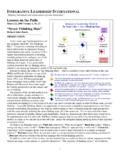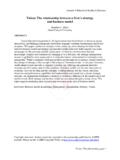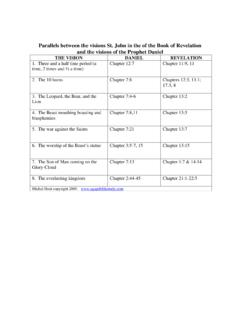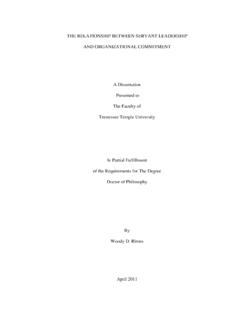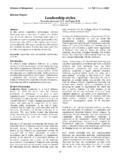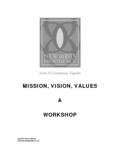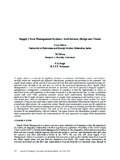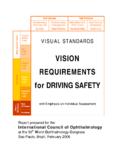Transcription of Learning and Leadership - Integrative Leadership International
1 Exploring the relationship between Learning and Leadership Lillas M. Brown Director Business and Leadership Programs Extension Division University of Saskatchewan Saskatoon, Saskatchewan S7N 5C8 CANADA and Barry Z. Posner Dean and Professor of Leadership Leavey School of Business Santa Clara University Santa Clara, CA 95053 USA (FAX: 408-554-4553) Published The Leadership & Organizational Development Journal November 2001 1 Exploring the relationship between Learning and Leadership Abstract This paper investigates how two important research streams, namely Learning and Leadership , might be related with one another.
2 Responses on the Learning Tactics Inventory (Dalton, , 1999) and Leadership Practices Inventory (Kouzes and Posner, 1997) are compared for a managerial sample (N = 312). Results indicate that more active and versatile learners subsequently consider themselves more frequently involved and engaged in Leadership behaviors. Implications for transformational Learning and Leadership theories are explored, as well as thoughts about how the development of Leadership competencies may be enhanced and affected by various Learning techniques.
3 Key Words Learning Leadership Leadership Development Learning Tactics Inventory Leadership Practices Inventory Transformational Learning 1 Exploring the relationship between Learning and Leadership Learning and Leadership represent two rich lines of research: One is about how people learn and the other is about how people lead. In this study we attempt to connect these two ideas together: What relationship does the way that people learn have with the manner in which they lead?
4 How do people learn? This has been, and continues to be, the subject of voluminous research studies. Most consider Learning from either a trait-based approach or as various information-processing strategies. Similarly, researchers investigate whether Learning begins from an inside out or outside in perspective. In the last two decades, scholars have advanced a transformational Learning theory that has received more attention than any other adult Learning theory and continues to be of interest (Taylor, 1997).
5 Transformational Learning theory builds upon previous lines of inquiry into adult Learning such as androgogy and self-directed Learning . Mezirow (1994: 222) defines transformational Learning as the process of construing and appropriating a new or revised interpretation of meaning of one s experience as a guide to action. Essentially this approach to Learning is about change dramatic and fundamental change in the way we see ourselves and the world in which we live. Kegan (2000) describes transformational Learning as an expansion of consciousness and observes that this kind of Learning is more than merely adding to what we already know.
6 Transformational Learning shapes people, asserts Clark (1993:47): they are different afterwards, in ways both they and others can recognize. Rather than focusing on adult learner characteristics, as andragogy and self-directed Learning theories tend to do, transformational Learning centers squarely on the cognitive process of Learning . The mental constructions of experience, inner meaning, and reflection are common components of this approach (Merrion & Cafferella, 1999). Key concepts in transformational Learning are: (a) experience critical incidents or trigger events; (b) critical reflection content reflection, process reflection, and premise reflection (examine long held beliefs, values about the experience); (c) affective Learning feelings play a primary role in triggering reflection, (d) dialogue and relationships that are supportive and trusting and, (e) individual development (Taylor, 2000).
7 Experience is envisioned as the starting point in this approach and becomes the content for reflection. Engaging the life experience in a critically reflective manner is a necessary condition for transformation. Indeed, the entire process of Learning is a journey of change change that is growth enhancing and developmental (Mezirow, 2000). The question of how people learn to lead is more narrowly focused than the broader topic of Learning and, not surprisingly, reveals more widespread consensuses.
8 For instance, in analyzing thousands of case studies, Kouzes and Posner (1995) found that people reported Learning how to lead from three sources: trial and error, observation of others, and education. Honeywell undertook a six-year research program to determine how managers learn to manage. Findings from their study revealed these three categories: job experiences and assignments, relationships, and formal education/training (Zemke, 1985). The Center for Creative Leadership 2 interviewed successful executives to find out what career events they considered to be important in their development and clustered the results into these sets: job assignments that the executives had experienced; other people with whom they had come into contact; hardships they had endured; and formal training (McCall, Lombardo, & Morrison, 1988).
9 More recently, research from the Center indicates that about 75% of the events that individuals report as critical to their careers comes from a combination of Learning from the work itself and Learning from others (Dalton, Swigert, VanVelsor, Bunker, & Wachholz, 1999). The case has been made about the importance of Learning as a foundational element in effective Leadership . Vaill (1999), for example, explains how the importance of Learning is underscored by the exceedingly turbulent and unpredictable organizational environments within which corporate managers and executives are working.
10 There is basically no limit, he says, to the kinds of Learning a contemporary leader may have to engage: All managerial leaders are feeling a dramatic quickening in the pace of change, an increasing complexity to their choices and a greater and greater cost of being wrong. There is a continual stream of things managers have to learn in order to thrive in this environment (119). It may make more sense to say that in the present world, Leadership is not learned but rather that it is Learning . When we observe a leader at work, what we may really be observing is a Learning process and an exceedingly complex Learning process at that.
